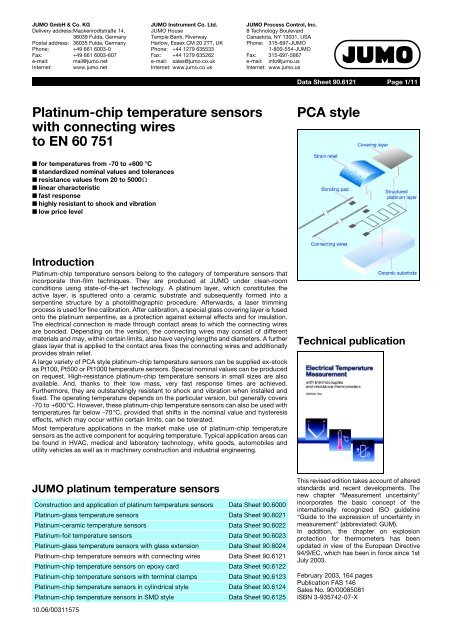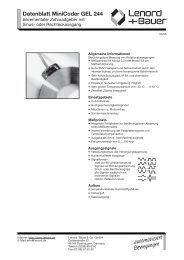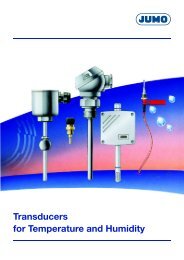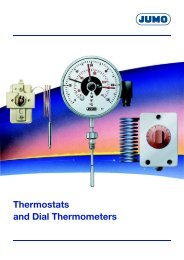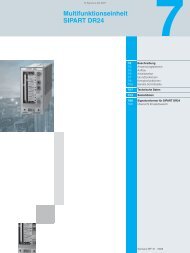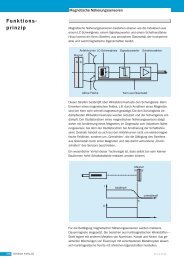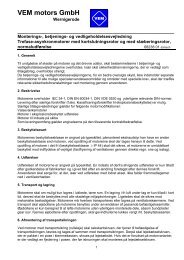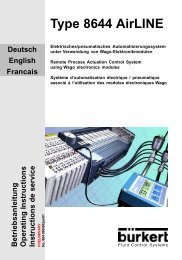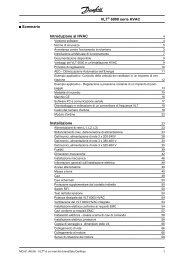Platinum Temperature Sensors - Nuova Elva
Platinum Temperature Sensors - Nuova Elva
Platinum Temperature Sensors - Nuova Elva
Create successful ePaper yourself
Turn your PDF publications into a flip-book with our unique Google optimized e-Paper software.
JUMO GmbH & Co. KG<br />
Delivery address:Mackenrodtstraße 14,<br />
36039 Fulda, Germany<br />
Postal address: 36035 Fulda, Germany<br />
Phone: +49 661 6003-0<br />
Fax: +49 661 6003-607<br />
e-mail: mail@jumo.net<br />
Internet: www.jumo.net<br />
JUMO Instrument Co. Ltd.<br />
JUMO House<br />
Temple Bank, Riverway<br />
Harlow, Essex CM 20 2TT, UK<br />
Phone: +44 1279 635533<br />
Fax: +44 1279 635262<br />
e-mail: sales@jumo.co.uk<br />
Internet: www.jumo.co.uk<br />
JUMO Process Control, Inc.<br />
8 Technology Boulevard<br />
Canastota, NY 13031, USA<br />
Phone: 315-697-JUMO<br />
1-800-554-JUMO<br />
Fax: 315-697-5867<br />
e-mail: info@jumo.us<br />
Internet: www.jumo.us<br />
Data Sheet 90.6121 Page 1/11<br />
<strong>Platinum</strong>-chip temperature sensors<br />
with connecting wires<br />
to EN 60 751<br />
PCA style<br />
■ for temperatures from -70 to +600 °C<br />
■ standardized nominal values and tolerances<br />
■ resistance values from 20 to 5000Ω<br />
■ linear characteristic<br />
■ fast response<br />
■ highly resistant to shock and vibration<br />
■ low price level<br />
Introduction<br />
<strong>Platinum</strong>-chip temperature sensors belong to the category of temperature sensors that<br />
incorporate thin-film techniques. They are produced at JUMO under clean-room<br />
conditions using state-of-the-art technology. A platinum layer, which constitutes the<br />
active layer, is sputtered onto a ceramic substrate and subsequently formed into a<br />
serpentine structure by a photolithographic procedure. Afterwards, a laser trimming<br />
process is used for fine calibration. After calibration, a special glass covering layer is fused<br />
onto the platinum serpentine, as a protection against external effects and for insulation.<br />
The electrical connection is made through contact areas to which the connecting wires<br />
are bonded. Depending on the version, the connecting wires may consist of different<br />
materials and may, within certain limits, also have varying lengths and diameters. A further<br />
glass layer that is applied to the contact area fixes the connecting wires and additionally<br />
provides strain relief.<br />
A large variety of PCA style platinum-chip temperature sensors can be supplied ex-stock<br />
as Pt100, Pt500 or Pt1000 temperature sensors. Special nominal values can be produced<br />
on request. High-resistance platinum-chip temperature sensors in small sizes are also<br />
available. And, thanks to their low mass, very fast response times are achieved.<br />
Furthermore, they are outstandingly resistant to shock and vibration when installed and<br />
fixed. The operating temperature depends on the particular version, but generally covers<br />
-70 to +600°C. However, these platinum-chip temperature sensors can also be used with<br />
temperatures far below -70°C, provided that shifts in the nominal value and hysteresis<br />
effects, which may occur within certain limits, can be tolerated.<br />
Most temperature applications in the market make use of platinum-chip temperature<br />
sensors as the active component for acquiring temperature. Typical application areas can<br />
be found in HVAC, medical and laboratory technology, white goods, automobiles and<br />
utility vehicles as well as in machinery construction and industrial engineering.<br />
Technical publication<br />
JUMO platinum temperature sensors<br />
Construction and application of platinum temperature sensors Data Sheet 90.6000<br />
<strong>Platinum</strong>-glass temperature sensors Data Sheet 90.6021<br />
<strong>Platinum</strong>-ceramic temperature sensors Data Sheet 90.6022<br />
<strong>Platinum</strong>-foil temperature sensors Data Sheet 90.6023<br />
<strong>Platinum</strong>-glass temperature sensors with glass extension Data Sheet 90.6024<br />
<strong>Platinum</strong>-chip temperature sensors with connecting wires Data Sheet 90.6121<br />
<strong>Platinum</strong>-chip temperature sensors on epoxy card Data Sheet 90.6122<br />
<strong>Platinum</strong>-chip temperature sensors with terminal clamps Data Sheet 90.6123<br />
<strong>Platinum</strong>-chip temperature sensors in cylindrical style Data Sheet 90.6124<br />
<strong>Platinum</strong>-chip temperature sensors in SMD style Data Sheet 90.6125<br />
10.06/00311575<br />
This revised edition takes account of altered<br />
standards and recent developments. The<br />
new chapter “Measurement uncertainty”<br />
incorporates the basic concept of the<br />
internationally recognized ISO guideline<br />
“Guide to the expression of uncertainty in<br />
measurement” (abbreviated: GUM).<br />
In addition, the chapter on explosion<br />
protection for thermometers has been<br />
updated in view of the European Directive<br />
94/9/EC, which has been in force since 1st<br />
July 2003.<br />
February 2003, 164 pages<br />
Publication FAS 146<br />
Sales No. 90/00085081<br />
ISBN 3-935742-07-X


